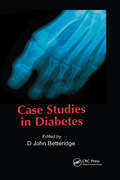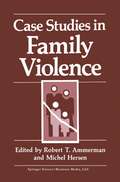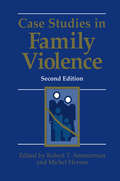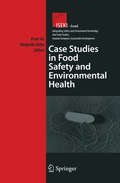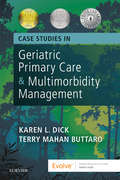- Table View
- List View
Case Studies in Diabetes
by D John BetteridgeWith the increasing incidence of Type 2 diabetes in the adult population and the realization that this is a vascular disease and a major coronary risk factor, Professor Betteridge has chosen fifty diabetologists to contribute a case which has had an effect on their clinical practice. Both Types 1 and 2 diabetes are included, along with other forms of diabetes, eg gestational. Each case is presented in the same format. The various cases are informative and educational and should provide the reader with a sounder knowledge of patient and disease types.
Case Studies in Diabetes
by D John BetteridgeWith the increasing incidence of Type 2 diabetes in the adult population and the realization that this is a vascular disease and a major coronary risk factor, Professor Betteridge has chosen fifty diabetologists to contribute a case which has had an effect on their clinical practice. Both Types 1 and 2 diabetes are included, along with other forms of diabetes, eg gestational. Each case is presented in the same format. The various cases are informative and educational and should provide the reader with a sounder knowledge of patient and disease types.
Case Studies in Diagnostic Imaging: Film Interpretation for Postgraduate Examinations
by Patric Nisbet Wladyslaw Gedroyc Sheila RankinImaging now plays an integral part in most diagnostic pathways. A familiarity with plain-film abnormalities and the more specialised modalities such as computerised tomography, ultrasound, nuclear medicine and magnetic resonance is an important part of the clinician's "medical knowledge", and a sound grasp of the subject is expected in postgraduate examinations. This book is primarily intended as a study guide for film interpretation in postgraduate examinations, especially the MRCP and FRCR exams. The layout of the questions follows the format of the examination of the Royal College of Radiologists. On right-hand pages brief clinical details and one or more imaging examples are presented for the candidate to analyse and report. In each case specimen answers with comments and, where necessary, further illustrations, are shown on the following left-hand page. This text cannot be comprehensive, but it should form a foundation for future study. Finally, we are very grateful to our many colleagues who have provided additional material for this book. London, 1987 Patric Nisbet Wladyslaw Gedroyc Sheila Rankin Introduction Guidance for FRCR Candidates Since April 1984 the Final Fellowship examination of the Royal College of Radiologists has included a new section: the Film Viewing Session. One hour is allotted to this session, with eight candidates being examined at one time using identical sets of cases. Each candidate is given eight packets of films and each packet may contain up to three films. Relevant clinical data is included with each individual case.
Case Studies in Emergency Medicine: LEARNing Rounds: Learn, Evaluate, Adopt, Right Now
by Colin G. Kaide Christopher E. San MiguelThis book contains a variety of medical case studies from actual patients presenting to the emergency department. It includes not only typical cases that present to the ED but also less common, yet very important cases that one can't afford to miss. Each chapter begins with a case – or set of cases with typical and atypical aspects – of the disease in question. This is followed by high-value learning points on the condition with introductory/background points, physiology and pathophysiology of the disease, how to make the diagnosis, and finally how to initiate treatment. The cases provide expert discussion with tips and tricks, personal experience with management of each of the cases, and a follow-up description of the outcome of the cases to provide the reader with closure. To supplement each case study, all 67 chapters include a pattern recognition component that identifies the key diagnostic features of the disease discussed. The chapters conclude with a summary of the diagnostic and treatment details of each condition. Using a concise, easy-to-read, bulleted format, the book helps readers to learn, evaluate, adopt new practices, right now (LEARN). Emergency Medicine Case Studies - LEARNing Rounds: Learn, Evaluate, Adopt, Right Now is an essential resource for a variety of emergency medicine clinicians including experienced physicians, residents, physician assistants, nurse practitioners, nurses, and medical students rotating in the emergency department. Finally, this book can be used as a basis for small group discussions, especially in emergency medicine training programs.
Case Studies in Emergency Medicine: A Collection of Memorable Clinically Relevant Cases with Clinical Pearls
by Volker WenzelIn this book, experienced emergency physicians describe, in a way that is both suspenseful and instructive, often dramatic and humanly touching emergency scene calls with which they have been confronted in the course of their professional lives. Each case is discussed and finishes with a conclusion to help in future practice. Emergency physicians and ambulance staff thus receive valuable tips for their own future work.
Case Studies in Ethics and HIV Research
by Sana Loue Earl C. PikeThis important work takes as its subject one of medicine’s most pressing arenas of ethical debate. There has been a consistent interest in ethical issues arising in the context of HIV research. Ongoing international and multi-site studies and the continuing search for an HIV vaccine continue to prompt examination of how this research is conducted. Also examined are how participants are engaged in the studies and the obligations of the researchers to individual participants and their communities during the course of and following the conclusion of the research. Each chapter of this book is authored primarily by one of the editors (secondarily by the other) and is accompanied by one to two case studies.
Case Studies in Family Violence
by Robert T. AmmermanThe past 20 years have seen the emergence of family violence as one of the most critical problems facing society. The alarming incidence figures of abuse and neglect directed toward family members justify this atten tion. For example, over 1 million children are thought to be abused and neglected each year. Similarly, almost 2 million women are victims of wife battering each year. Annual rates of elderly mistreatment are thought to be as high as 32 per 1000 population. Accurate epidemiologi cal data only now are being compiled on more recently recognized forms of mistreatment, such as psychological abuse, ritualistic abuse of chil dren, and child witnessing of adult violence. The pervasiveness of do mestic mistreatment makes it a priority for clinicians and researchers alike. For clinicians, intrafamilial violence represents a formidable chal lenge with respect to assessment and treatment. The etiology of abuse and neglect is multidetermined. There are numerous pathways in the development of family violence, and these interact and converge in a nonlinear fashion. The consequences of family violence are equally com plex and divergent. Victims of mistreatment can display a variety of physical injuries and psychological disturbances. No single psychiatric syndrome or symptom constellation has been consistently implicated in any form of family mistreatment. The perpetrators of family violence are equally heterogeneous in their clinical presentations. Illustrative dys functions in perpetrators include skill deficits, substance abuse, mental illness, and impulse-control disorders.
Case Studies in Family Violence
by MichelHersen Robert T. AmmermanSince the publication of the first edition in 1991, there has been substantial progress in our understanding of the etiology and associated features of domestic violence. As in the first edition, this book elucidates and highlights the complex multidisciplinary issues facing clinicians who work with family violence cases. Each chapter combines two illustrative cases with a broader discussion of the issues that are encountered by clinicians working with families that engage in abuse or neglect.
Case Studies in Food Safety and Environmental Health (Integrating Food Science and Engineering Knowledge Into the Food Chain #6)
by Peter Ho Maria Margarida Cortez VieiraThis book presents food safety concepts and issues in a practical and applied framework for use in the classroom. It covers microbial food safety, chemical residues and contaminants, and risk assessment and food legislation. These sections can be used individually or together to discuss a range of issues. Each chapter has a summary of the issues discussed, objectives, and discussion questions focused on the major issues.
Case Studies in Forensic Epidemiology
by Sana LoueEpidemiology has often been defined as the study of the distribution of disease, together with the distribution of factors that may modify that risk of disease. As such, epidemiology has often been reduced to a methodology only, providing a mechanism for the study of disease that is somehow removed, separate and apart from the populations that serve as its focus. Epidemiology, however, is much more than that. The discipline p- vides a way of perceiving and knowing the world, and of relating to the c- munities whose health and disease patterns we are trying to understand. As such, its usefulness extends past the construction of questionnaires, the detective work inherent in tracing the source of an infection or the analysis of data. Rather, epidemiology serves as a point of reference and a linkage between various domains of reality: in the courtroom, between a com- nity’s injuries and those alleged to be responsible for those violations; between the community striving to effectuate changes to improve its health and environment and the lawmakers and policymakers whose actions may dictate or control the likelihood of that change; and between “mainstream” populations and those who become or remain marginalized and stigmatized due to disease or perceived disease.
Case Studies in Geriatric Primary Care & Multimorbidity Management - E-Book
by Terry Mahan Buttaro Karen DickGain expertise in primary care of older adults with a case-based approach to geriatric primary care and multimorbidity management. Written by two leading academic and clinical experts in geriatric primary care, Case Studies in Geriatric Primary Care and Multimorbidity Management, 1st Edition uses detailed Exemplar Case Studies and Practice Case Studies to teach you how to think like an expert geriatric clinician. Because most older adults have more than one condition when seeking care, both Exemplar and Practice Case Studies place a strong emphasis on "multimorbidity" management, (the management of patients with a host of complex, interacting conditions). To provide extensive practice in learning how to think like an expert, case studies reflect the reality that care does not necessarily begin or end in the primary care setting. Cases therefore move fluidly from primary care to acute care to inpatient rehabilitation to assisted living to long-term care. Building on foundational introductory chapters, cases also call on you to develop interprofessional collaboration skills and reflect the diversity of today's older adults, in terms of age (young-old to old-old), gender, culture, ethnicity, sexuality, socioeconomic status, and more! As you work through both basic-level and advanced Practice Case Studies, you can make extensive notes in the printed book and then go online to submit answers for grading and receive expert feedback for self-reflection.NEW! Introductory unit on the core principles of caring for older adults gives you a strong foundation in the principles of geriatric primary care and multimorbidity management.NEW! and UNIQUE! Exceptionally detailed, unfolding Exemplar Case Studies demonstrate how an expert advanced practitioner "thinks clinically" to provide care to older adults with multiple conditions. NEW and UNIQUE! Exceptionally detailed, unfolding Practice Case Studies emphasize patient diversity and multimorbidity management across healthcare settings to help you develop advanced clinical reasoning skills for geriatric primary care. NEW and UNIQUE! Strong emphasis on multimorbidity management focuses on caring for older adults with multiple chronic conditions. NEW! Emphasis on the continuum of care across settings reflects the reality that care does not necessarily begin or end in the primary care setting but can move from primary care to acute care to inpatient rehabilitation to assisted living to long-term care, and so forth.NEW! Online answer submission for grading and expert feedback for self-reflection.NEW! Emphasis on patient diversity reflects the makeup of today's older adult, population in terms of age (young-old to old-old), gender, culture, ethnicity, sexuality, socioeconomic status, and more.NEW! Emphasis on interprofessional collaboration use Exemplar Case Studies and Practice Case Studies to allow you to demonstrate your interprofessional collaboration skills.
Case Studies in Gerontological Nursing for the Advanced Practice Nurse (Case Studies in Nursing #13)
by Meredith Wallace Kazer Leslie Neal-BoylanAs the fastest growing population sector worldwide, older adults are seen in almost every care setting in which clinicians practice. Developed as a resource for advanced practice nurses in any setting, Case Studies in Gerontological Nursing for the Advanced Practice Nurse presents readers with a range of both typical and atypical cases from real clinical scenarios. The book is organized into six units covering cases related to ageism, common health challenges, health promotion, environments of care, cognitive and psychological issues, and issues relating to aging and independence. Each case follows a similar format including the patient's presentation, critical thinking questions, and a thorough discussion of the case resolution through which students and clinicians can enhance their clinical reasoning skills. Designed to promote geriatric clinical education through self-assessment or classroom use, Case Studies in Gerontological Nursing for the Advanced Practice Nurse is a key resource for all those dedicated to improving care for older adults.
Case Studies in Gerontological Nursing for the Advanced Practice Nurse (Case Studies in Nursing #12)
by Meredith Wallace Kazer Leslie Neal-BoylanAs the fastest growing population sector worldwide, older adults are seen in almost every care setting in which clinicians practice. Developed as a resource for advanced practice nurses in any setting, Case Studies in Gerontological Nursing for the Advanced Practice Nurse presents readers with a range of both typical and atypical cases from real clinical scenarios. The book is organized into six units covering cases related to ageism, common health challenges, health promotion, environments of care, cognitive and psychological issues, and issues relating to aging and independence. Each case follows a similar format including the patient's presentation, critical thinking questions, and a thorough discussion of the case resolution through which students and clinicians can enhance their clinical reasoning skills. Designed to promote geriatric clinical education through self-assessment or classroom use, Case Studies in Gerontological Nursing for the Advanced Practice Nurse is a key resource for all those dedicated to improving care for older adults.
Case Studies in Global School Health Promotion: From Research to Practice
by Carmen E. Aldinger Cheryl Vince WhitmanA growing body of research identifies strong links between children’s health, social and educational outcomes; it also notes the reciprocal benefits of access to quality education on individual and family health status. In response to these findings, the World Health Organization developed the concept of the Health-Promoting School (HPS), a living catalyst for healthy lives, and for positive changes that students can take home and into the community. Case Studies in Global School Health Promotion provides readers with a theoretical and research base needed to understand the methods used in communities all over the world to put this captivating concept in place. Case examples from over two dozen countries (representing urban and rural areas in developing and developed nations) outline the strategies taken to implement HPS programs in individual schools, municipalities, and nations. For each program, case study authors explain the problems they tackled, their motivation and supports to respond creatively; and the barriers they faced. In the cases, authors describe the capacities and infrastructure they created and mechanisms for cooperation; as well as the personnel, financial, and time requirements involved. Case studies were drawn from the following regions: Africa The Americas Europe Eastern Mediterranean South and Southeast Asia Western Pacific. Case Studies in Global School Health Promotion offers a world of insights, ideas, and guidance to those addressing social determinants of health at this formative stage, including: education and health policy makers; professionals and administrators; and researchers in national governments, universities, local schools, community, non-governmental organizations and civil society. The material provides interesting and useful information to those dedicated to these issues within WHO, FRESH Partners and other United Nations agencies. It is also an instructive text for graduate students in public health, education, allied health professions and social sciences.
Case Studies in Immunology: A Clinical Companion (7th Edition) (PDF)
by Raif Geha Luigi NotarangeloCase Studies in Immunology, Seventh Edition is intended for medical students and undergraduate and graduate students in immunology. It presents major topics of immunology through a selection of clinical cases that reinforce and extend the basic science. Each case history is preceded by essential scientific facts about the immunological mechanisms of that specific disorder. The cases themselves demonstrate how immunological problems are deconstructed in the clinic and each one is followed by a concise summary of the clinical finding and questions which can serve as discussion points. The book includes a total of 55 cases and can be used as either a standalone text, review aid, or as a companion to Janeway’s Immunobiology, Ninth Edition and The Immune System, Fourth Edition.
Case Studies in Immunology: A Clinical Companion
by Raif Geha FRED RosenThis case study is about a 29-year-old professional oboe player who was first diagnosed for optic neuritis and then for multiple sclerosis (MS). MS is an example of a T-cell mediated autoimmune disease, wherein there is an autoimmune attack on the integrity of the central nervous system.
Case Studies in Immunology: A Clinical Companion
by Raif Geha FRED RosenThis case study is about a 29-year-old professional oboe player who was first diagnosed for optic neuritis and then for multiple sclerosis (MS). MS is an example of a T-cell mediated autoimmune disease, wherein there is an autoimmune attack on the integrity of the central nervous system.
Case Studies in Immunology: A Clinical Companion
by Raif Geha FRED RosenThis book presents case histories to illustrate essential points about the mechanisms of immunity and to explain some of the immunological problems seen in the clinic. It is intended to help medical students and pre-medical students to understand the importance of basic immunological mechanisms.
Case Studies in Immunology: A Clinical Companion
by Raif Geha FRED RosenThis book presents case histories to illustrate essential points about the mechanisms of immunity and to explain some of the immunological problems seen in the clinic. It is intended to help medical students and pre-medical students to understand the importance of basic immunological mechanisms.
Case Studies in Immunology: A Clinical Companion
by Raif Geha FRED RosenThis case study is about an autoimmune disease triggered by infection. It describes how Gwendolen Fairfax, a healthy, unmarried 34-year-old bank manager, who developed the sudden onset of fever, cough and anemia, was started on erythromycin by intravenous administration for treatment.
Case Studies in Immunology: A Clinical Companion
by Raif Geha FRED RosenThis book presents a case history of a patient with acute infectious mononucleosis, to illustrate in a clinical context essential points about the mechanisms of immunity; and to explain some of the immunological problems seen in the clinic. It is helpful for medical and pre-medical students.
Case Studies in Immunology: A Clinical Companion
by Raif Geha FRED RosenThis case study is about a 31-year old lady with blood group A, Rh-negative red cells, who was diagnosed for a fetus in immunological distress. Though elimination of the hemolytic disease of the newborn is possible, alloimmunization may fail in mothers even after giving them purified immunoglobulin.
Case Studies in Immunology: A Clinical Companion
by Raif Geha FRED RosenThis is a case study of a 12-year-old boy who received massive intravenous penicillin and ampicillin injections to treat pneumonia and developed a serum sickness reaction to the antibiotics. Serum sickness can prove fatal if it provokes kidney shutdown or bleeding in a critical area.
Case Studies in Immunology: A Clinical Companion
by Raif Geha FRED RosenThis case study of a boy with juvenile diabetes illustrates a complication of poorly controlled insulin-dependent diabetes mellitus (IDDM), namely diabetic glomerulosclerosis. In IDDM, the kidneys are damaged, renal failure ensues and the only therapy, except hemodialysis, is renal transplantation.
Case Studies in Immunology: A Clinical Companion
by Raif Geha FRED RosenThis book presents a case history of a patient with lepromatous leprosy, to illustrate in a clinical context essential points about the mechanisms of immunity and to explain some of the immunological problems often seen in the clinic. It is helpful for medical students and pre-medical students.
